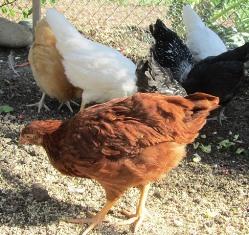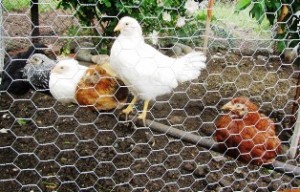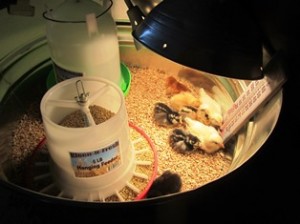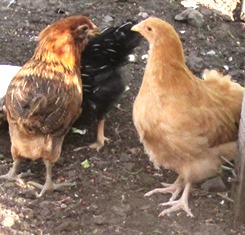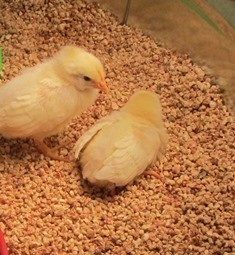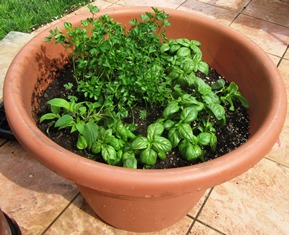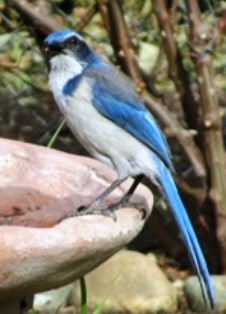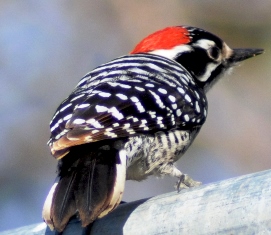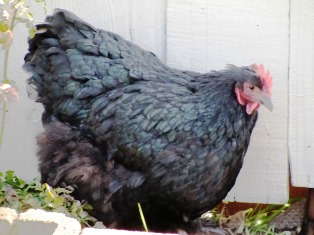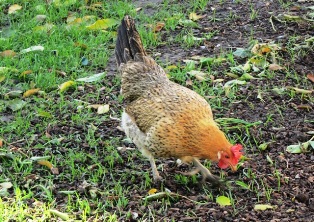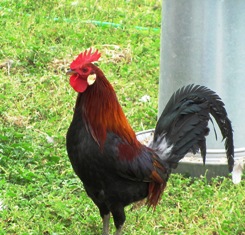Archive for the 'Animals' Category
You Can’t Hurry a Chicken into Laying an Egg
I brought home my little flock of baby chicks on March 7. Yesterday marked 16 weeks or four months. That’s important because that’s when the feed store told me I could start expecting eggs from my White Leghorns. Not with mine. They are taking their own sweet time.
The Rhode Island Red can take between 20 and 26 weeks–or so I’ve been told–to start laying. Mine just wants to forage in the yard, follow me around, get in my face, and eat any extra blueberries that I didn’t consume with my morning yogurt and honey. I had a talk with her yesterday about how I’m expecting some eggs in return for all those blueberries.
My flock also includes a Buff Orpington, a Black Sex Link, an Ameraucana, and two Silver Laced Wyandottes, the latter is an old heritage breed can take up to 32 weeks to begin laying. So maybe around Halloween, I’ll find their first offerings.
In anticipation of the big egg-laying event, I’ve switched the chicken food to a crumble for laying hens. Tomorrow I will buy some oyster shell calcium for strong egg shells. I’ve also tucked smooth, wooden eggs into their nesting boxes with some soft straw, hoping to encourage the girls to get with it.
Their voices have now changed from the peep, peep, to cluck, cluck. But I’ve yet to hear that loud cackle that tells me an egg has been laid. Sometimes I’ll see one of some serious squatting and get excited. Okay, this is it. But so far, it isn’t.
So the watch goes on. You can’t hurry a chicken who isn’t ready to produce eggs. So in the meantime, I’ll be eating a lot more yogurt and berries for breakfast.
Stealing Away to Visit the County Fair
My daughter dropped by for a girl’s day out at the county fair. Summer chores are endless so taking a day off riddled me with guilt–and guilty pleasure.
We strolled under ancient, white bark sycamore trees that towered 50 to 100 feet above us. The first thing we saw as we entered the arched fair-grounds gate were goat pens. The cute little milking goats drew us over, but the odor of mounds of fresh horse manure turned us away. We kept on walking.
We moseyed over to see the sheep with their docked tails (apparently sheep like to chew on the tails of other sheep, so docking the tails eliminates pain and suffering and is more hygienic). We thought the baby goats were adorable. We marveled at how the pigs appeared so pink, healthy and robust. We couldn’t help but stare at the massive bellies and large bags of the dairy cows.
Embarking on the path to the exhibit halls, we relished how cool it was inside, a veritable respite from the heat. We strolled down aisles of quilts, art by high school students, and displays of jewelry. Then it was time to check out the jams. The entries of strawberry dominated the competition, but some included jam made with fig, plum, or rhubarb.
During the dessert competition, pies, brownies, and cakes beckoned us to peer into the glass display shelves. My daughter lamented that she wished they were for sale, reminding us it was time to eat.
We passed on the roasted corn on the cob and cotton candy, choosing simple tacos and Pennsylvania Dutch-style funnel cakes. I washed my meal down with the hibiscus-flavored drink sitting next to a dispenser of white horchata while my daughter stuck with water.
Before we left the exhibit halls and animals, I wanted to see the chickens. That competition must have happened on a different day, so I wandered over to the peacock pens next to the pigeons, finches, and parakeets. The peacocks were lovely but there were no peahens.
We checked out the bunny cages (I didn’t know there were so many kinds of rabbits) and decided against even looking at the reptiles (I tend to dream about them once I see them–and snake dreams aren’t usually pleasant).
All that walking and sensory stimuli wore me out. By the time we arrived home in the late afternoon, I needed a nap. I thought a day off was supposed to rejuvenate you. Instead, mine had done me in, but the trip to the fair gave me gobs of ideas for my cozy mystery series.
One Curious Chicken and a Five-Gallon Pot
Rhody, the friendliest, most communicative chicken I’ve ever owned is the smallest in my flock of little hens. Barely 16 weeks old and not yet laying eggs, she would be a teenager in human years, I suppose. And like a teenager, she is curious and appears to thrive on new experiences.
Yesterday, the Rhode Island Red’s curiosity got her into a hot spot, literally.
The blood orange sun had nearly disappeared over the farmette’s western fence when I noticed a chicken missing from the flock. I was sitting outside trying to feel cool for it had been a searing hot day. As dusk set in, I noticed the chickens moving toward the hen house.
It didn’t take long to figure out that Rhody wasn’t among them. Panic set in as I recalled a couple of hawks circling the farmette earlier. I ran inside and woke my husband from his nap and the two of us set out on a search.
We covered all of our property and then ventured into the neighbor’s acre. We found no chicken feathers that might indicate a tussle with a hawk and my spirits should have been buoyed by that . . . but I imagined other terrible scenarios.
Fighting back tears, I followed my husband back through the gate to our farmette. Not about to give up the search, I retraced my steps to the garden. On the way, I kicked over an upside down black container that had held a five-gallon fruit tree.
And there stood Rhody. She remained frozen like she was as stunned to see me as I was to find her. She must have been under that container during the hottest hours of the day without water or food. She seemed weak, but not as bad off as I would have expected being trapped in 90-plus degree heat.
She managed to wobble back to the hen house on her own two legs. Eschewing the perch, she crouched down for the night in a straw-lined nesting box.
This morning, curious Rhody was the first out of the chicken house. As she made a beeline for the garden, I found myself remembering that old adage about how curiosity can kill a cat. In Rhody’s case, it almost cooked a chicken!
Outwitting the Moles
Last year, our garden went under siege to moles, voles, and gophers. They drove us crazy with tunnels, tracks, and earth mounds–the means to devour our newly planted bulbs and plants. We didn’t see signs of the voles but we knew we had them, too, when one showed up drowned in a post hole after a rainstorm.
But whether the rodent is a gopher, vole, or mole, they are unwanted pests in my garden. This year, my husband and I decided they could roam around if they wanted, but we were going to protect our plants one way or another.
For our heirloom blue tomatoes, Carlos built four -by-six feet boxes to hold soil. For each, we nailed small-hole poultry wire over the bottom, then flipped the box over to set in place on the ground.
We then filled the box with alternating layers of natural soil, compost, and dried horse manure (any type of manure must be dried and aged or it’ll be hot and kill your plant).
We planted, staked, and watered the tomatoes. We’ve seen no evidence of rodent tunnels despite having planted in an area where we know there are tunnels. We’re thrilled with the result. I just may have to do my whole garden in boxes next year.
Dealing with a Flock of Stressed-Out, Feathered-Out Chicks
Now that the weather has turned warm here in Northern California, I have moved my baby chicks from the huge box in my kitchen to our newly constructed chicken house. I don’t know for certain, but I think they were feeling stressed out in the box and I was stressed from the noise and their behaviors of pecking each other and trying to fly out of the box.
The hen house has two windows that open and close for ventilation, nesting boxes, a front door for my access, a back exit door with stairs for the chickens to enter and leave, and a couple of perches inside and out. We wired a poultry screen over the top of the chicken run because of the predatory habits of local hawks.
Our chicks range in age from eight and ten weeks and are all feathered out. I feed them medicated crumble and provide fresh water daily. To ensure strong legs, I cover the chicken house floor with a bed of dried, crushed corn cob. I also have stuffed straw into the three nesting boxes so that when the chickens are ready to begin laying, they’ll have a bed ready.
The chicks are growing so fast, their girth and height seems to double every week. The bulk of their diet is crumble, but with an occasional treat such as shredded fresh lettuce and spinach leaves. Their activities and often-flighty behaviors are notable for chickens. They take dust baths, scratch the earth for grubs and worms, run at each other while seemingly intent on crashing only to avert at the last minute, perch together to roost, and peck their housemates. Oh, the pecking!
Guess which chicken is the most aggressive pecker from my flock that includes White Leghorn, Silver-Laced Wyandotte, Buff Orpington, Rhode Island Red, Black Sex Link, and an Ameraucana. Turns out,in my flock, the most aggression is shown by the Buff Orpington.
From day one, “Buffy” has pecked the quiet Ameraucana. Before the Ameraucana had feathered out, blood would flow from her back from Buffy’s senseless pecking. I tried to separate them, giving Buffy time outs and hoping to stop her behavior. It seemed to work . . . or, maybe I was just imagining it was.
I placed a dab of antibiotic cream on the back of the Ameraucana and within days, her pecking wound healed and now she’s feathered again over the wound. The move to the chicken house reduced the stress of living out of a box in the kitchen. Now the chickens seem to get along fine, even enjoying their life in the hen house.
Last night, Buff huddled up next to the Ameraucana on the roost and this morning I saw the two of them taking a dust bath together. Chicken stress relief. My stress relief. It’s a beautiful thing!
Chicklet Therapy: Raising Baby Chicks
I’m raising a flock of baby chicks in a tub in my kitchen. Watching them is nothing short of a stress-busting exercise. Not only do they provide endless entertainment, but they already show individual temperaments and personality traits that can’t help but make you smile.
Some people raise backyard chickens for both meat and eggs. Others want only eggs (I’m in that group). And there are those who love keeping the more exotic breeds–imagine feathered legs and toes, cheek muffs, beards, and strange-looking combs.
There are so many breeds, it’s hard to keep track of them all. For example, there are the standards like the White Leghorns and Rhode Island Reds; the exotics like the Faverolles (with their five toes, feathered feet, and fluffy beards and muffs), and heritage chickens.
Traditional breeds or “heritage” chickens aren’t as popular as they once were, so their numbers are declining. Some are even considered Of the heritage chickens whose numbers are declining so rapidly that they are considered globally endangered. They include Campines, Andalusians, Buttercups, Catalanas, Sumatras, and other breeds.
My baby chick choices include a Rhode Island Red, a Buff Orpington, two Silver-Laced Wyandottes, two White Leghorns, a Black Sex Link, and an Ameraucana (who lays blue-green eggs). All are known to be good layers, although some are more productive than others.
Egg production can go down during periods of molting (losing their feathers) or broodiness (sitting on the eggs as though they will hatch, which they won’t because without a rooster, the eggs are not fertile). Also, egg production can decline during winter when the daylight hours are shorter.
The following guidance comes from my local feed and pet supply store, Concord Feed, Pet, and Livestock Supply. See, http://www.concordfeed.com. The store’s capable staff are all extremely knowledgeable about chicks. Here are the guidelines.
1. The environment must be clean, warm, and dry (no drafts). Consider a brooder’s box or large galvanized tub filled with dry and mold-free bedding such as corn cob shavings (Bed-O-Cobb is a good one). Avoid smooth, slick surfaces that can cause leg damage.
2. They must have room to roam. The rule of thumb is 1 square foot per chick; when they are six weeks and older, given them 2 square feet per bird.
3. Day-old chicks need 90 to 95 degrees Fahrenheit. To achieve this, attach a heat lamp or light bulb about 20 inches above the chicks. When cold, the baby chicks tend to huddle together under the lamp for warmth; when hot, the chicks move to the corners. You will want to reduce the temperature created by the heat lamp by five degrees each week until you reach the ideal temperature of 65 degrees Fahrenheit. Simply move the lamp further away from the chicks.
4. Hydrate the chicks with a one-quart of fresh, cool water in a dispenser that is changed daily (or more often if they scratch bedding or food into it). A quart container will provide enough water for 25 chicks.
5. Feed the babies with a chick starter until they are 16 to 20 weeks old. By that age, they should be feathered completely. Then begin giving the hens a laying feed to help them produce strong-shelled eggs and provide them with the nutrients they require.
By following these guidelines, I think I’ll be able to have eggs from my little hens by August or September this year, barring any of them turning out to be roosters. In case I must give him up (some cities don’t allow roosters), which I wouldn’t want to do, I’ve already talked to the feed store about rooster rescue organization. For helpful information about keeping chickens, see http://www.backyardchickens.com/
Telltale Signs of Spring
As I write this, the honeybees are scouting every plant on the property. Awakened by warm weather and sunlight, they search for nectar. Aside from a few California poppies and other wildflowers blooming in front of the house, they won’t find much to forage on just yet.
Of course, there are a few apricot, nectarine, and almond tree blossoms as well as a smattering of white strawberry blooms in the raised beds at the back of our property. But within a few weeks, the warm weather of March and April will render the farmette virtually covered in masses of sweet offerings for the honeybees.
Still, there are the early signs of spring. The Japanese maples are leafing out in a dazzling show of red color. The pregnant stems of our bearded iris are swelling now for their Easter bloom cycle. And the Greek oregano is popping up everywhere as it does this time of year.
Birds are building nests, but I haven’t seen the red-breasted robins just yet. When they show up, searching for worms and grubs, I will know spring has truly arrived. Until then, I look for the telltale signs that Mother Nature is about to robe herself in the splendid garments of spring–fruit tree blossoms, leaves, blooming wildflowers, and lovely kitchen herbs pushing up all over the place.
Pair Bonding and Nest Building Is for the Birds
Nothing is sweeter to this farmette owner’s ears that the trills, tweets, and peet-a-weets of the backyard songbirds. Of late, we’ve been highly entertained, especially since the male songbirds seem to be in courtship mode, singing and doing air acrobatics in an effort to woo a female into bonding with them. Nest building comes after that.

Mourning Doves mate for life; these two are joined at the feeder by a third who has lost her partner
The Mourning Doves sound their plaintive call during flight or at rest on a wire waiting for the right time to alight on the ground, which is where they prefer to feed. Lately, however, I’ve seen a pair feeding together in the tight space around a feeder. Of late, a third has joined them.
The Western Scrub Jay isn’t really a songbird. He competes with the mockingbird, who is especially vocal, for the highest perch in the tree where it sits lookout and squawks until it spots an acorn and swoops down to take it in its beak for burial, most likely somewhere in my yard. At first, we saw only one or two jays and now there are four or more hanging out near the many feeders and suet cakes that we’ve hung for the birds.
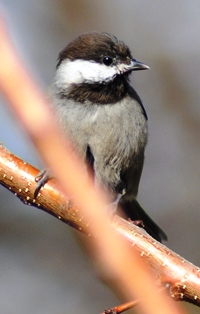
The Gray-headed Chickadee’s habitat is in northwestern Canada and Alaska, so what’s it doing on a Bay Area farmette?
The above bird passed through and posed long enough for a picture in our apricot tree. We think it is a Gray-headed Chickadee, but when we look the bird up in the Audubon book, it seemed unlikely since that bird doesn’t travel through Northern California. Still, the image of our bird seems to match exactly that of a Gray-headed Chickadee.
The flashiest bird of all in our backyard hangs upside down at the suet box, pecking away at the embedded seeds and pieces of fruit in the suet cake. He’s the Nuttall’s woodpecker and he’s found a mate. She’s hanging around, scouting out nesting sites. We’re trying to deter them from using a hole in our old farmette roof strut, but I think we’re losing the battle. Every morning, we hear the rat-ta-tat-tatting of bird beak against wood near the front porch. I’ve covered each hole they’ve made, but they keep drilling new ones.
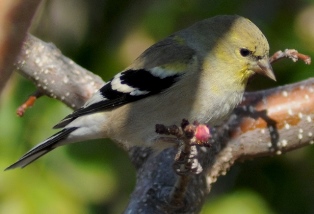
The Pine Warbler perches contentedly in the apricot tree after dining on insects, bugs, larvae, spiders, and caterpillars as well as the fruit and seeds embedded in the suet cake
Another bird that proved difficult for us to identify is the above pictured Pine Warbler. We have a massive pine tree in front of the farmette and with the suet cakes hanging at the back, this guy must have moseyed from the tall pine tree to drop in and taste a bit. These birds sing a rapid 10 to 30 notes at a time, usually on one pitch. Like most songbirds, they have song and also have defensive sounds, like a rattle call or a short, sharp note they sound to warn of predators or danger.
Certain Plants And Chickens Don’t Go Together
Chickens are curious creatures. Spend a hour watching them scratch, poke, and peck and you’ll see what I mean.
I’ve never lost a free-range chicken because of something it ate; but it seems as though they’ll eat anything. It got me thinking that a variety of plants commonly grown in landscapes and backyard gardens could make chickens ill if they ate the berries, nuts, or leaves of those plants.
The following represents a small sampling of common plants that could make your feathered friends sick or even poison them.
- Acorn
- Alfalfa
- Azalea
- Daffodil
- Eggplant
- Foxglove
- Hemlock
- Jasmine
- Jimson Weed
- Lamb’s Quarters
- Lantana
- Milkweed
- Nicotiana (tobacco)
- Oleander
- Oxalis
- Poison Ivy
- Poison Oak
- Pokeweed
- Pyracantha
- Red Maple
- Rhubarb
- Sweet Pea
- Tulip
- Wild Onion
- Wisteria
Chickens are foraging birds and have good natural instincts. They will taste a plant and if something isn’t right, they’ll likely leave it. If you allow them to forage for themselves in pasture, more often than not, they’ll eschew the poisonous plants in your garden or landscape for the rich diversity of what they find in open pastureland.
If Your Chickens Aren’t Cold Hardy, What Can You Do?
Chickens that can tolerate extreme cold are considered cold-hardy. The Dominique, Hamburg, Langshan, Sussex, and Wyandotte breeds are considered chill tolerant (even cold-hardy) but breeds such as Crevecoeur and Catalana are less tolerant of temperature extremes. So are Bantams and some breeds with large, single combs.
The chickens generate body heat that helps alleviate the cold temperature of a coop. They also wear feathered coats and will huddle together for warmth. A hen house that has insulation and perhaps a south-facing window that captures the warmth of a winter sun can also mitigate extreme cold.
Still, if you live in an area where the temps are below freezing, where it snows, and where the wind contributes to the chill, you might want to hang an ordinary light bulb (40-60 watts) or a 50-watt red bulb if you worry about frost-bitten chickens on those coldest nights.
Put that lamp on a timer. But beware of hanging any electric light that could get knocked down. It could set your coop on fire. And cold-tolerant breeds probably don’t need the extra heat anyway.
Perhaps equally, if not more, important are the chickens’ need for fresh water, ventilation, and a dry environment during winter. You don’t want the chickens roosting in a draft, but you do need ventilation in the coop, for example, via egg-access doors, windows, or ventilation holes with screens. They also need a dry environment.
If the coop isn’t insulated, you might stack bales of straw or hay along the walls and scatter pine shavings if your coop has an earthen floor that becomes cold or frozen.

This chicken house has egg access doors, a human door, a window, and is insulated; the art is optional.
Cold-hardy chickens probably will make it through most frosty nights with few to no problems. Your best tool is your ability to observe your chickens for problems. Oh, and you might want to place a thermometer inside the coop for an accurate measurement about how cold it really gets when the ladies (and rooster, too) are all inside.
Don’t judge your chickens’ endurance for cold by your own.
 Facebook
Facebook Goodreads
Goodreads LinkedIn
LinkedIn Meera Lester
Meera Lester Twitter
Twitter




